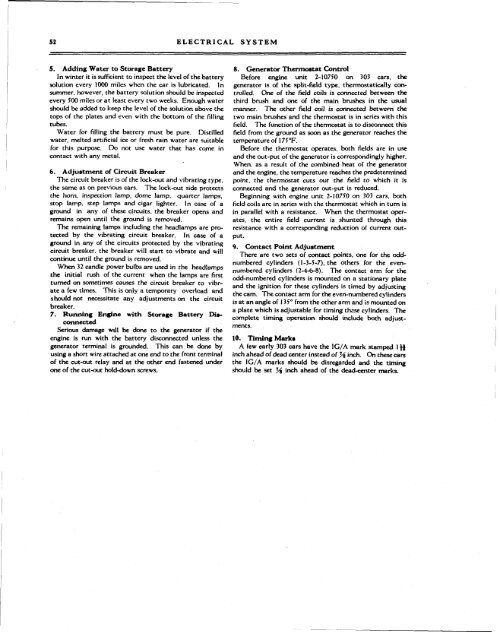1928 Cadillac - GM Heritage Center
1928 Cadillac - GM Heritage Center
1928 Cadillac - GM Heritage Center
Create successful ePaper yourself
Turn your PDF publications into a flip-book with our unique Google optimized e-Paper software.
52 ELECTRICAL SYSTEM<br />
5. Adding Water to Storage Battery<br />
In winter it is sufficient to inspect the level of the battery<br />
solution every 1000 miles when the car is lubricated. In<br />
summer, however, the battery solution should be inspected<br />
every 500 miles or at least every two weeks. Enough water<br />
should be added to keep the tevel of the solution above the<br />
tops of the plates and even with the bottom of the filling<br />
tubes.<br />
Water for filling the battery must be pure. Distilled<br />
water, melted artificial ice or fresh rain water are suitable<br />
for this purpose. Do not use water that has co.me in<br />
contact with any metal.<br />
6. Adjustment of Circuit Breaker<br />
The circuit breaker is of the lock-out and vibrating type,<br />
the same as on previous cars. The lock-out side protects<br />
the horn, inspection lamp, dome lamp, quarter lamps,<br />
stop lamp, step lamps and cigar lighter. In case of a<br />
ground in any of these circuits, the breaker opens and<br />
remains open until the ground is removed.<br />
The remaining lamps including the headlamps are protected<br />
by the vibrating circuit breaker. In case of a<br />
ground in any of the circuits protected by the vibrating<br />
circuit breaker, the breaker will start to vibrate and will<br />
continue until the ground is removed.<br />
When 32 candle power bulbs are used in the headlamps<br />
the initial rush of the current when the lamps are first<br />
turned on sometimes causes the circuit breaker to vibrate<br />
a few times. This is only a temporary overload and<br />
should not necessitate any adjustments on the circuit<br />
breaker.<br />
7. Running Engine with Storage Battery Disconnected<br />
Serious damage will be done to the generator if the<br />
engine is run with the battery disconnected unless the<br />
generator terminal is grounded. This can be done by<br />
using a short wire attached at one end to the front terminal<br />
of the cut-out relay and at the other end fastened under<br />
one of the cut-out hold-down screws.<br />
8. Generator Thermostat Control<br />
Before engine unit 2-10750 on 303 cars, the<br />
generator is of the split-field type, thermostatically controlled.<br />
One of the field coils is connected between the<br />
third brush and one of the main brushes in the usual<br />
manner. The other field coil is connected between the<br />
two main brushes and the thermostat is in series with this<br />
field. The function of the thermostat is to disconnect this<br />
field from the ground as soon as the generator reaches the<br />
temperature of 175 °F.<br />
Before the thermostat operates, both fields are in use<br />
and the out-put of the generator is correspondingly higher.<br />
When, as a result of the combined heat of the generator<br />
and the engine, the temperature reaches the predetermined<br />
point, the thermostat cuts out the field to which it is<br />
connected and the generator out-put is reduced.<br />
Beginning with engine unit 2-10750 on 303 cars, both<br />
field coils are in series with the thermostat which in turn is<br />
in parallel with a resistance. When the thermostat operates,<br />
the entire field current is shunted through this<br />
resistance with a corresponding reduction of current output.<br />
9. Contact Point Adjustment<br />
There are two sets of contact points, one for the oddnumbered<br />
cylinders (1-3-5-7), the others for the evennumbered<br />
cylinders (2-4-6-8). The contact arm for the<br />
odd-numbered cylinders is mounted on a stationary plate<br />
and the ignition for these cylinders is timed by adjusting<br />
the cam. The contact arm for the even-numbered cylinders<br />
is at an angle of 135° from the other arm and is mounted on<br />
a plate which is adjustable for timing these cylinders. The<br />
complete timing operation should include both adjustments.<br />
10. Timing Marks<br />
A few early 303 cars have the 1G/A mark stamped 1H<br />
inch ahead of dead center instead of % inch. On these cars<br />
the IG/A marks should be disregarded and the timing<br />
should be set % inch ahead of the dead-center marks.
















